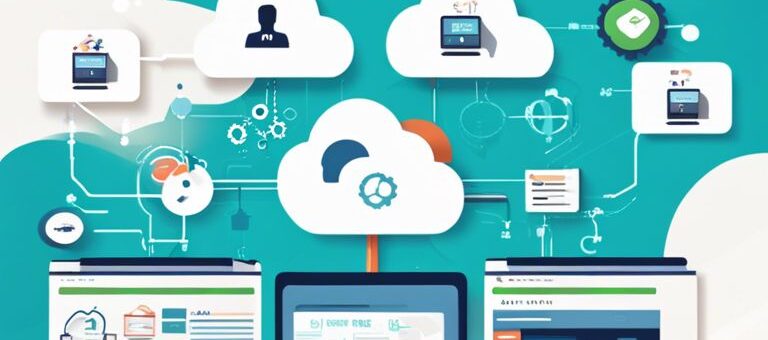Guide your way through the booming world of Software As A Service (SaaS) with my ultimate roadmap! I’ve seen how this game-changing model can supercharge your business, but I also know the risks that come with poor choices. In this guide, I’ll share everything I’ve learned—how to choose the right tools, avoid common pitfalls, and leverage SaaS for maximum efficiency. Trust me, getting this right can change the trajectory of your business, so let’s dive in and make sure you’re steering in the right direction!
Navigating Software As A Service – A Comprehensive Guide
What is SaaS?
The definition of Software As A Service, or SaaS, is pretty straightforward. It refers to a software distribution model where applications are hosted on a service provider’s servers and made available to users over the internet. Essentially, you access the software via a web browser instead of installing it directly on your local machine. This means automatic updates, no headaches of maintenance, and you can say goodbye to the traditional licensing model!
There’s a whole world of SaaS solutions out there, catering to everything from project management tools to customer relationship management (CRM) systems. What’s great about SaaS is that it allows businesses of all sizes to use high-quality software at a fraction of the cost of traditional software options. Think about it like renting an apartment vs. buying a house. You get the flexibility to scale up or down based on your needs without getting bogged down by long-term commitments!
Key Features of SaaS
Clearly, there are several key features that make SaaS an attractive option for businesses and individuals alike. Here’s what you can expect:
- Accessibility: Easily accessible from any device with internet connectivity.
- Cost-effectiveness: You only pay for what you use, saving you money on hardware and maintenance.
- Scalability: Quickly scale services up or down based on your organizational needs.
- Automatic Updates: Software providers handle updates automatically, so you’re always using the latest version.
- Collaboration: Built-in features to enhance teamwork, no matter where team members are located.
Thou, understanding these features can help you make an informed decision about whether SaaS is the right fit for your business needs! And don’t forget that the overall benefits of SaaS significantly outweigh any drawbacks!
Let’s dig deeper into what makes these features so powerful:
- Accessibility: Work from anywhere, anytime, as long as you’ve got internet.
- Cost-effectiveness: Reduce spending on infrastructure and maintenance fees.
- Scalability: Easily adapt resources to meet changing demands.
- Automatic Updates: No more manual updates or compatibility issues.
- Collaboration: Real-time collaboration tools enhance productivity.
Thou, by understanding these features, you can leverage the power of SaaS to your advantage and enhance productivity in your organization!
Types of SaaS Solutions
SaaS platforms have evolved tremendously, and there are a couple of major categories you should know about. You’ve got your vertical market SaaS solutions, which are tailored to specific industries, and then there are horizontal market SaaS options that can be applied across a wide range of sectors. Let’s break this down!
| Vertical Market SaaS | Specialized for particular industries (e.g., healthcare, retail) |
| Horizontal Market SaaS | General software applicable across multiple sectors (e.g., CRM, accounting) |
| Collaboration Tools | Facilitates team collaboration (e.g., project management, communication) |
| Business Intelligence Tools | Enhances data analysis and decision-making (e.g., reporting dashboards) |
| HR Management Systems | Streamlines HR processes (e.g., recruitment, payroll) |
For those eager to explore, the types of SaaS solutions help define the landscape within which you can find tools that suit your business needs. These services cater to varying demands—from industry-specific applications to broad solutions that can propel growth and efficiency across your entire organization!
- Vertical Market SaaS: Designed for niche industries.
- Horizontal Market SaaS: General-purpose tools for various markets.
- Collaboration Tools: Aid remote work and teamwork.
- Business Intelligence Tools: Improve data insights.
- HR Management Systems: Streamline workforce management.
Assume that your SaaS journey will enrich your organizational efficiency and help you stay ahead in a fast-paced digital landscape!
Software solutions will continue evolving, and as they do, understanding SaaS’s core principles will put you in a position to leverage these technologies effectively. Stay ahead of the curve, adapt to changing demands, and you’ll find SaaS not just a tool, but an vital part of your arsenal for modern business success!
Pros and Cons of SaaS
One of the most significant parts of understanding Software As A Service (SaaS) is diving deep into its pros and cons. You need to weigh these two sides to make informed decisions for your business. At first glance, SaaS seems like an all-in-one solution, but is it really? Here’s a breakdown of what SaaS can offer you and what you should keep an eye on:
| Pros | Cons |
|---|---|
| Scalability to accommodate your growth | Dependence on internet connectivity |
| Cost-effective with a subscription model | Ongoing costs can add up over time |
| Automatic updates and maintenance | Limited customization options |
| Accessibility from any device | Potential security risks |
| Quick setup and deployment | Vendor lock-in challenges |
| Enhanced collaboration features | Data privacy concerns |
| Integration with other tools | Possible performance issues during peak times |
| Customer support options | You may lose features if you downgrade |
| Trial periods to test functionality | May not be the best fit for all businesses |
| Environmentally friendly (less hardware) | Constant need for reliable bandwidth |
Advantages of Using SaaS
Clearly, the advantages of using SaaS make a strong case for integrating it into your operations. First off, the scalability it provides is undeniable. As your business expands, you can easily upgrade your plan without dealing with the cumbersome process of installing new hardware or software. And let’s not forget cost savings; without hefty upfront expenditures, you can shift funds to critical areas like marketing and product development.
Not to mention, you’re getting automatic updates and maintenance, which means you can stay focused on what really matters—running your business. Your team can access the software from any device, giving them the freedom to collaborate remotely, which is imperative in today’s work environment. It’s a win-win!
Disadvantages to Consider
SaaS solutions come with their own set of challenges to think about. SaaS technology, while powerful, puts your reliance on internet connectivity front and center. If your internet connection goes down, so does your ability to access critical business applications. And let’s be real—if you’re in a situation where the internet isn’t reliable, you could be looking at some serious downtime.
To complicate matters further, you may encounter issues with vendor lock-in. If you choose to shift gears or explore other platforms, migrating your data can be more challenging than you initially anticipated. Plus, with cloud servers hosting your data, security concerns are always looming. I can’t stress enough how crucial it is to vet your SaaS provider’s security practices before committing.
Step-by-Step Guide to Choosing the Right SaaS
Despite the abundance of Software as a Service (SaaS) options flooding the market today, the process of choosing the right one doesn’t have to be overwhelming. I mean, sure, everyone claims to offer the best solution, but the trick lies in finding the one that aligns perfectly with your specific needs and goals. To help you out, I’m breaking this down into a step-by-step guide that you can follow to make an informed decision.
Identifying Your Needs
Identify Your Needs
Right off the bat, you need to dig deep and ask yourself what it is you’re trying to achieve. What are the specific problems you want to solve? What features do you absolutely need? This isn’t just about going with the popular choice; it’s about tailoring your search to satisfy your unique requirements. I can’t stress enough how imperative this step is. Create a checklist of the features most important to you, whether it be integrations, user-friendliness, or support capabilities. With that clarity, you’ll steer clear of wasteful spending and buyer’s remorse.
Understanding your needs sets the stage for the entire decision-making process. If you don’t know what you want, how can you choose wisely? Take some time to analyze your organization, scout for gaps in your workflow, and pinpoint your must-have features. This clarity will empower you to compare solutions objectively down the road, ensuring your SaaS choice adds real value to your life.
Explore Available Options
Explore Available Options
Some of you might be thinking that you can just Google “best SaaS tools” and call it a day. But hold your horses! It’s crucial to take a more structured approach to exploring the myriad SaaS solutions available today. Dive into industry forums, check out review sites like G2 or Capterra, and don’t forget to solicit recommendations from your peers or mentors who may have been in your shoes before. Knowledge is power, and the more angles you cover, the richer your insights will become.
StepbyStep, after gathering a list of potential candidates, it’s vital to look into the company’s reputation and customer support. Not every SaaS provider is created equal, and some may offer subpar support, leaving you hanging when issues arise. Research user feedback, and watch out for red flags. If a tool has great features but a disastrous support track record, that could spell trouble down the line.
StepbyStep, I’d recommend narrowing your options to around 3-5 providers that stand out in your research. This manageable list makes it easier for you to start diving deeper into their pricing, offerings, and specific user experiences.
Evaluate Pricing Models
Evaluate Pricing Models
Even when you’ve identified viable options, don’t rush into a decision based on just features. Pricing models can vary dramatically between platforms, which can play a huge role in your long-term satisfaction. You’ll find monthly subscriptions, yearly commitments, and usage-based pricing models. Each has its pros and cons that can impact your budget down the line. I always say, make sure you’re not just comparing price tags, but also the value you’re getting for that money.
For instance, while a cheaper solution may seem like a great deal upfront, if it lacks necessary features or robust customer support, you could end up paying dearly in lost productivity and frustration. So weigh your options carefully, and don’t shy away from asking for detailed pricing plans upfront. The more transparent, the better. That way, you leave no stones unturned.
Test Before You Invest
Test Before You Invest
The last thing you want is to commit to a SaaS solution, only to find out it makes your life harder instead of easier. That’s why I can’t stress enough the importance of taking advantage of free trials or demos. Request these when available, and spend real quality time using the software. Get into the nitty-gritty and see how it integrates or fits with your workflow. Ask yourself—does it genuinely enhance your productivity?
Models that offer trial periods or freemium options are golden. It gives you peace of mind, knowing you’ve done your homework and vetted your choice extensively. My advice? Treat the trial period like you’re hiring someone. You wouldn’t just make a hire based on their resume, would you? You want to see them in action!
Models like these allow you to fully assess whether the product lives up to its promises before you put your hard-earned cash on the line. Just remember, whatever your choice, do your due diligence and stay critical. Your business deserves nothing less than the best!
Tips for Successful SaaS Implementation
Many organizations investigate Software as a Service (SaaS) solutions hoping for immediate results, but without a solid game plan, this can lead to missed opportunities and wasted resources. To ensure your SaaS implementation is a success, keep these crucial tips in mind:
- Clearly define your goals and objectives.
- Engage with stakeholders early and often.
- Invest in thorough training and onboarding.
- Regularly monitor and assess the performance of your SaaS solution.
- Maintain open lines of communication with your SaaS provider.
This approach will equip you with the tools needed for a meaningful and effective SaaS experience, ultimately empowering your team and transforming your business operations.
Onboarding Your Team
An effective onboarding process is critical in achieving long-term success with any SaaS solution. Begin by ensuring that your team is informed about the new platform and understands its capabilities. This isn’t just a one-time session; I recommend organizing ongoing workshops and training sessions to help your team get comfortable with the software. When your team knows how to leverage the features available, they can maximize the value derived from the service, which directly reflects on your bottom line.
Moreover, it’s imperative to create a feedback loop during the onboarding phase. Encourage your team to share challenges and insights they encounter while using the platform. You’ll find that iterative learning and adaptation will not only enhance comfort levels but will also foster a culture of collaboration and continuous improvement.
Integrating with Existing Systems
Implementation of a new SaaS solution doesn’t mean you have to abandon your existing systems. You want a seamless transition, and that requires careful consideration of how the new platform will integrate with tools you’re already using. It’s critical to assess the interoperability of the new software with your legacy systems and, if possible, enlist the help of your IT department to map out the best integration strategies.
Additionally, pay attention to data migration. You want to ensure that critical information from your existing systems is accurately moved over, without loss or corruption. Leveraging APIs or middleware tools can streamline this process, ensuring every layer of your software stack communicates effectively.
Onboarding your existing systems into new SaaS applications can save you time and resources, eliminating redundancies and providing a unified experience for your team and customers alike.
Ongoing Support and Maintenance
Onboarding goes beyond the initial training phase; you need to ensure ongoing support and maintenance are part of your overall strategy. Regular check-ins with your SaaS provider can help identify potential performance issues and provide solutions before they become problems. It’s crucial not to go radio silent after implementation; the landscape of software and solutions is always changing, and so should your approach. Addressing challenges as they arise fosters a healthy relationship with your SaaS provider and ensures your software continues to serve your needs effectively.
I suggest setting up a dedicated support channel for your team to report issues or suggest enhancements. The more efficient your team feels about addressing questions or challenges, the more likely they are to remain engaged with the software, ultimately driving better productivity.
Support doesn’t just mean resolving issues; it’s about investing in continual learning and optimizing your usage of the platform. This mindset shift can lead to a more successful and sustainable SaaS implementation, with positive long-term outcomes for your business.
Summing up
So, as I wrap up this comprehensive guide on navigating Software as a Service (SaaS), I want you to really take a moment and think about the impact this technology can have on your life and business. You’ve got access to tools that can elevate your game, streamline operations, and turbocharge your productivity. Don’t sleep on leveraging these platforms to empower your workflow! I promise you, once you dive in, you’ll see the insane value it can bring. It’s all about making those strategic moves, aligning with the right solutions, and being open to evolving your processes. You hold the keys to your own success in this SaaS-driven world.
I can’t stress enough how crucial it is to stay informed and adaptable in this ever-changing ecosystem. The landscape is always evolving, and it’s on you to keep your eyes peeled for new opportunities. Embrace the challenges, learn from them, and become the savvy user who capitalizes on the best tools out there! Note, it’s not just about using SaaS; it’s about using it effectively to propel you forward. So get out there and make things happen. Your future self will thank you for it. Let’s crush this together!


